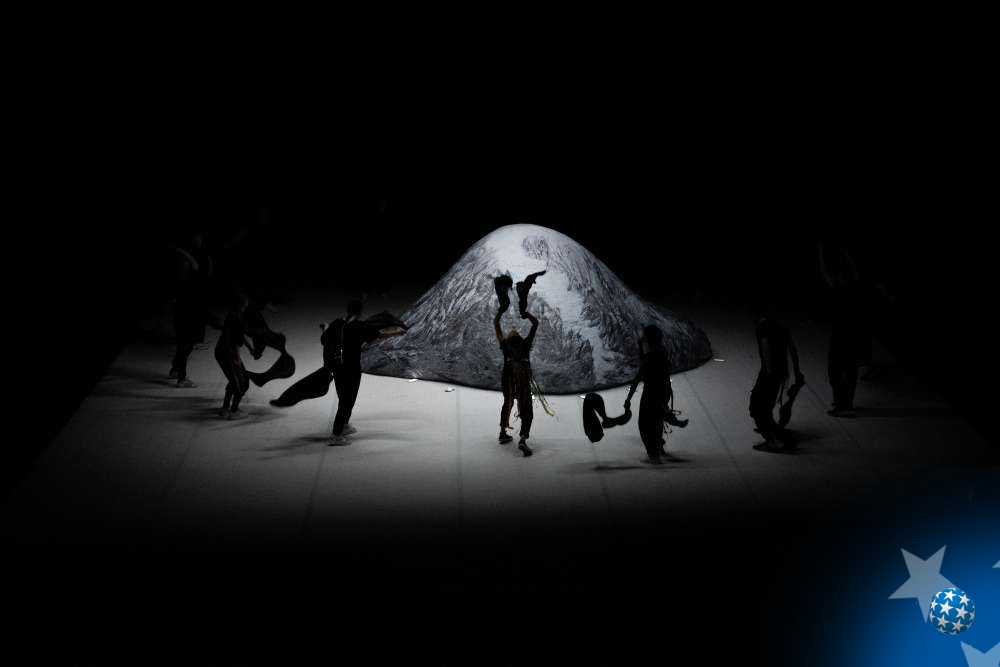Amanda Piña strives to decolonise art through her work and is focused on social and political power of movement. Answering the question what decolonization means to her, she said that in this moment, when modern colonial powers are trying to erase and deny any other form of knowledge, which she considers violence, we are left in the world of universality. That is why all the other forms of thought and meaning remain forgotten. Because of that, she believes that decolonization has to be linked with the culture of remembrance.
Minja Bogavac noticed that the performance Climatic Dances consists of two segments, one aesthetic and another political, and asked the members of the team which one they consider more important. Everyone agreed that the two cannot be separated, saying that separating art from activism would also represent an act of colonialism. Their entire work, they explained, is based on merging between these two aspects, which is also reflected in an interesting concept that precedes each performance. Namely, wherever they perform, also in Belgrade, the team arrive several days earlier and organize workshops with young dancers who, then, become a part of the performance and join the authors in the final part of the performance. That approach reflects their intention to share some of their knowledge and way of thinking, to break with the concept which implies that an author displays his work without actually being present. Asked how political and socially engaged topics are accepted in Mexican and Chilean theatre, Piña drew a parallel between South America and the Balkans, noticing that both regions have a strongly developed tradition of political theatre, which she is very proud of.
An important aspect of Climatic Dances is South American people’s ritual dance, which was explored through the process, and then incorporated into the performance. In the spirit of de-colonialism, one of the dancers, Lina Maria Venegas, said that it was important for them to introduce the ritual which is the root of modern dance. Ritual is important because is brings awareness of who we are, both as individuals and as a community.
Asked by Bitef Blog how she sees the role of the political theatre and if she believes that theatres like this really can bring about changes in the society, Piña says that she cannot save the world since she is neither a politician nor a lawyer, but that this performance is her way of fighting the pain caused to her by the destruction of the environment in her homeland. Still, she finds the role of an artist a privileged one since artists make different worlds possible and shareable. That is how it is possible to share thought and discourse that one day can spur the society into action. She believes, too, that an individual cannot bring about the change, but that if we work together, and if we involve new generations, through time and space, a change can occur.
You can see the entire discussion at the link provided, or Bitef YouTube channel.
After the performance, we asked the audience for their opinions:
Maja Ristić, professor at the Faculty of Drama Arts
A very interesting performance. The stage design is particularly striking, a true spectacle. It tackles some key issues of the modern world, and I think that it sends a message which is very current and clear. A very interesting performance in every respect!”
Milica Sučević, editor of the portal Hoću u pozorište
I found the beginning very interesting, because it sends a serious message about the world we live in and the problem we, in Serbia, are also facing. The second part of the performance is dance and for me too abstract, so I couldn’t understand everything, but I liked how they represented the Earth breathing, and its heart beating which, in the end, stops. It is a very clear warning.
Đorđe Galić, actor
I liked the topic, because I think that it is very important to talk about these things, especially nowadays. There should be many performances of this sort, green theatre should be more visible and involved in the public life. I was surprized to see that it is more an installation and a performing act, and I liked it because we don’t get to see things like this very often here. Video is also very interesting, totally meditative. My favourite part was the ritual dance which takes us back to our beginnings and links us to nature, which is very important since we’ve become totally alienated from it.

